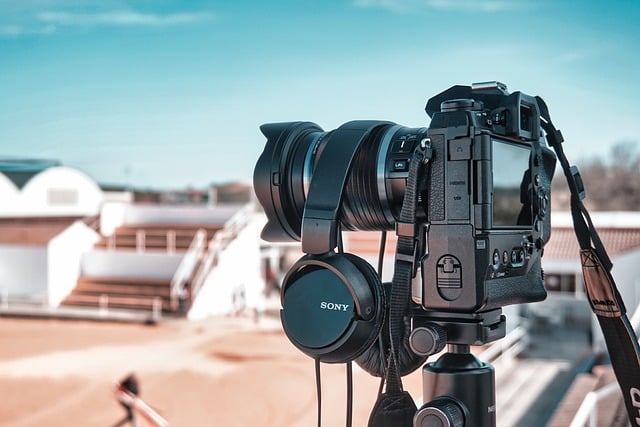Video compression, like converting DivX to AVI, involves removing less perceptible data to reduce file size. Advanced algorithms and customizable settings in tools like HandBrake and FFmpeg allow balancing size and quality. Choosing the right codecs and settings ensures video integrity and compatibility for diverse use cases.
Looking to compress your videos without losing quality? This comprehensive guide explores efficient video compression techniques, focusing on the powerful DivX and AVI formats. We’ll delve into the fundamentals of video compression, explain why these formats stand out, and provide a detailed step-by-step process for converting DivX to AVI. Learn best practices to maintain superior video integrity while achieving optimal file sizes. Discover top tools and tips to streamline your conversion process.
Understanding Video Compression: The Basics

Video compression is a process that reduces the size of video files while minimizing perceived quality loss. It involves eliminating redundant or less perceptible data from the original video, making it more efficient for storage and transmission. The goal is to strike a balance between file size and visual integrity; achieving a higher degree of compression can lead to smaller files but may result in noticeable artifacts or reduced clarity.
One common approach to understanding video compression is through formats like DivX and its associated container, AVI. Converting a DivX video to AVI often involves applying specific compression algorithms that adjust parameters such as bit rate, resolution, and frame rate. By tweaking these settings, users can control the trade-off between file size and quality, ensuring that the converted video retains its integrity while meeting storage or sharing requirements.
Why Choose DivX and AVI Formats?

Choosing the right video format is essential when aiming to compress your footage without any quality loss, and DivX and AVI offer a reliable solution for this purpose. Both formats are known for their superior compression capabilities while preserving the original video integrity, making them popular choices among users seeking to convert DivX to AVI.
DivX and AVI provide efficient compression algorithms that reduce file sizes significantly, ideal for saving storage space or optimizing videos for online streaming. The beauty lies in their ability to maintain sharp visuals, vibrant colors, and smooth frames, ensuring the converted video remains as close as possible to the original quality. This makes them excellent options for those who want to enjoy their favorite content without noticing any noticeable differences after compression.
Maintaining Video Quality During Compression

Maintaining video quality during compression is a delicate balance, especially when converting formats like DivX to AVI. High-quality video files often come with large file sizes, which can be problematic for sharing and storage. However, advanced compression algorithms have been developed to reduce file size without noticeable loss in visual integrity. These algorithms intelligently remove redundant data and compress the remaining information using efficient coding techniques, ensuring the video retains its original quality as much as possible.
When converting DivX to AVI, look for tools that offer customizable compression settings. This allows you to fine-tune the balance between file size reduction and preserving details in the video. Modern video converters often employ advanced codecs like H.264 or HEVC (H.265) that provide superior compression efficiency without sacrificing too much visual quality. Additionally, adjusting parameters like bitrate, resolution, and frame rate can significantly impact the final output, so it’s essential to understand these settings for optimal results when maintaining video integrity during compression.
Tools and Software for Efficient Conversion

When it comes to efficiently converting videos while preserving quality, several robust tools and software options are available. One popular choice for those looking to convert DivX to AVI format is HandBrake. This open-source software allows users to adjust various encoding settings, ensuring the output retains its integrity without unnecessary compression artifacts. With its user-friendly interface, HandBrake simplifies the process, making it accessible to both beginners and advanced users.
Another notable mention is FFmpeg, a powerful command-line tool that offers unparalleled flexibility. While it may take some time to master, FFmpeg provides an extensive range of options for video conversion, including DivX to AVI. Its cross-platform compatibility makes it a versatile choice for different operating systems, catering to users’ diverse needs in video conversion and manipulation.
Step-by-Step Guide: Convert DivX to AVI

Converting DivX to AVI is a straightforward process that allows you to maintain video integrity while achieving a more compatible file format. Here’s a step-by-step guide to help you through the process:
1. Choose a reliable converter: Start by selecting a video conversion tool that supports both DivX and AVI formats. Free and paid options are available, with many professional converters offering advanced features for higher quality outputs. Ensure the converter is capable of preserving original metadata and codecs for optimal integrity.
2. Install and launch the software: Once downloaded, install the chosen converter on your computer. After installation, open the application and locate the ‘Add File’ or ‘Import’ button. Navigate to your DivX video file, select it, and click ‘Open’. The converter should detect the file format and display relevant details for review.
3. Select output settings: Depending on your needs, tweak the conversion settings. Adjust parameters like resolution, frame rate, bitrate, and audio quality. For maintaining integrity, choose settings that match or closely resemble the original DivX file’s specifications.
4. Choose AVI as the output format: In the converter’s settings panel, look for an option to select the desired output format. Choose ‘AVI’ from the list of available formats. This will ensure your converted video retains compatibility with a wide range of media players and devices.
5. Start the conversion process: After confirming all settings, click on the ‘Convert’ or ‘Run’ button to begin processing. The converter will transcode the DivX video into the desired AVI format while preserving its integrity. Depending on the file size and complexity, this process may take a few minutes to complete.
6. Locate and verify the converted file: Once the conversion is finished, check the specified output folder for your new AVI file. Open it in a media player to ensure the video plays without disruptions or quality loss.
Common Issues and Tips for Optimal Results

When compressing videos, especially when converting DivX to AVI, common issues include reduced quality, video lag, or audio desync. These problems often arise due to incompatible codecs or settings that don’t balance compression and quality effectively. To achieve optimal results, ensure your video player and converter support the latest codecs. Use middle-ground settings instead of extreme ones; while higher bitrates preserve more detail, they also increase file size significantly. Regularly test different combinations to find the perfect balance for your specific video content.
Additionally, consider the purpose of the video. For instance, if it’s for online streaming, a moderate bitrate suitable for web standards might be all you need without compromising visual integrity. Remember that compression is about making files smaller while keeping essential details intact; thus, a thoughtful approach to settings will ensure the best outcome without noticeable quality loss.
Video compression is a necessary step to share or store high-quality footage efficiently, without compromising its integrity. By choosing the right formats like DivX and AVI, maintaining optimal settings during compression, and utilizing efficient tools, you can achieve top-notch results when converting DivX to AVI. Follow our step-by-step guide and tips for the best outcomes, ensuring your videos look as good as they did originally, no matter where or how they’re watched.
